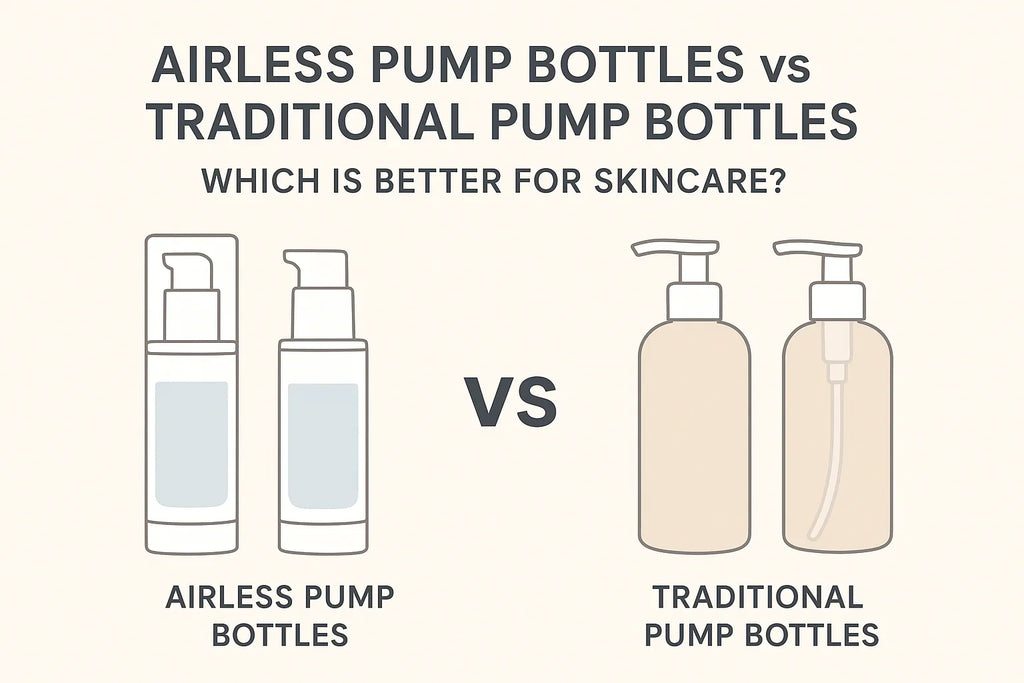Search
-
-
How to Customize ...
Dec 11, 2025 -
Eco-Friendly Perf...
Dec 01, 2025
Archive
- December 2025
- November 2025
- October 2025
- September 2025

Airless Pump Bottles vs Traditional Pump Bottles: Which Is Better for Skincare
Introduction: Why Packaging Matters in Skincare
When it comes to skincare and cosmetics, packaging isn’t just about looks—it directly affects product freshness, hygiene, and user experience. Two of the most common types are airless pump bottles and traditional pump bottles. But which one is better? In this guide, we’ll compare both and explain why many brands are switching to airless pumps.
How Traditional Pump Bottles Work
Traditional pump bottles use a dip tube that reaches down into the product. When you press the pump, the lotion or serum is pulled up through the tube and dispensed.
✅ Advantages of Traditional Pump Bottles
-
Widely available and cost-effective
-
Simple design and easy to use
-
Familiar to most consumers
❌ Disadvantages of Traditional Pump Bottles
-
Air enters the bottle with every pump, causing oxidation
-
Bacteria can contaminate the formula over time
-
Leaves product residue at the bottom—hard to use every drop
-
Not ideal for natural or preservative-free skincare
How Airless Pump Bottles Work
Airless pump bottles use a vacuum system instead of a dip tube. A hidden piston moves upward as you pump, pushing the product out without letting air inside.
✅ Advantages of Airless Pump Bottles
-
Protects formulas from air and bacteria
-
Extends shelf life of skincare products
-
Dispenses every last drop with no waste
-
Leak-proof and travel-friendly
-
Available as refill lotion bottles for sustainability
❌ Possible Drawbacks
-
Slightly higher cost than traditional bottles
-
First use requires priming (pressing a few times before product comes out)
Key Differences: Airless Pump Bottles vs Traditional Pump Bottles
| Feature | Traditional Pump Bottles | Airless Pump Bottles |
|---|---|---|
| Mechanism | Dip tube | Vacuum piston |
| Air Exposure | High (oxidation risk) | Minimal (airtight) |
| Product Usage | Leaves 5–10% wasted | Dispenses 100% |
| Hygiene | Risk of contamination | Protects from bacteria |
| Shelf Life | Shorter | Longer |
| Travel Safety | May leak | Leak-proof |
| Eco-Friendliness | Single-use mostly | Many are refillable lotion bottles |
Practical Applications of Airless Pump Bottles
Airless packaging isn’t just for luxury skincare—it works across many industries and product types:
-
Facial serums and anti-aging creams → protect delicate active ingredients like Vitamin C, retinol, or peptides.
-
Sunscreens → keep formulas stable against oxidation.
-
Eye creams → hygienic dispensing prevents contamination.
-
Liquid foundations → ensures smooth, controlled application without waste.
-
Travel-size skincare → leak-proof design makes them ideal for carry-ons.
-
Medical and pharmaceutical creams → maintain sterility and extend shelf life.
💡 If your brand deals with products that lose potency when exposed to air or light, airless pumps are the most reliable packaging choice.
Sustainability and Eco-Friendly Trends
Sustainability is no longer optional in the beauty industry—it’s a demand from eco-conscious consumers. Airless pump bottles play an important role in this movement:
-
♻️ Refill Options: Many airless bottles are designed as refill lotion bottles, reducing plastic waste.
-
🌍 Lower Carbon Footprint: By using every last drop, consumers buy fewer replacements.
-
✅ Premium Look + Eco Appeal: Combining luxury aesthetics with sustainability helps brands win customer trust.
-
🛍️ Regulatory Push: In regions like the EU, sustainable packaging is becoming a legal requirement—airless bottles are future-proof.
For brands, investing in eco-friendly airless pumps is both a sustainability decision and a marketing advantage.
👉 At SNPACKS, we offer refillable airless pump solutions to help brands stay ahead of both consumer demand and regulations.
Which One Should You Choose?
💡 If you’re using stable, low-cost products like hand soap or shampoo, traditional pump bottles may be sufficient.
But for premium skincare, natural cosmetics, or formulations with active ingredients, airless pump bottles are the clear winner. They preserve product quality, extend shelf life, and reduce waste.
That’s why more and more skincare brands are adopting airless pumps for serums, foundations, moisturizers, and sunscreens.
FAQ: Common Questions About Airless Pumps
Are airless pump bottles worth the higher cost?
Yes. They protect your skincare, reduce waste, and often double as refill lotion bottles, saving money long-term.
Can I travel with airless pump bottles?
Absolutely. They are leak-proof and TSA-friendly.
Do airless pumps work for thick creams?
Yes, airless pump bottles can dispense lotions, gels, and serums smoothly without clogging.
How do you refill an airless pump bottle?
Many designs are refillable. Simply remove the pump top, clean the container, and pour in your new product. This is especially useful for eco-conscious consumers who buy refills.
Can airless pump bottles be recycled?
Yes, most are made from recyclable materials like PET, PP, or acrylic. Some high-end versions even come with refillable cartridges for sustainable use.
Why won’t my new airless pump bottle dispense?
New bottles need a few extra pumps to prime the piston. Keep pressing, and the vacuum system will activate.
Conclusion: The Smart Packaging Choice
When comparing airless pump bottles vs traditional pump bottles, the advantages of airless packaging are clear: better hygiene, fresher skincare, less waste, and eco-friendly refilling options.
If you want your skincare to last longer and appeal to eco-conscious customers, choosing airless pumps is the smarter choice for both brands and consumers.
Related Reading
Want to learn more about how to use, clean, refill, and open airless pump bottles?
Check out our in-depth article: The Ultimate Guide to Airless Pump Bottle — a step-by-step resource covering everything you need to know about airless pumps, from first-time use to cleaning and refilling refill lotion bottles.
Contact us
Add: Building 7, Bairui Wuhuan Industrial Park, Taxi Road, Jinghe Street, Dongxihu District, Wuhan City, Hubei Province 430040, China
(+86)18963979371
(+86)027-83372627
info@snpacks.com









